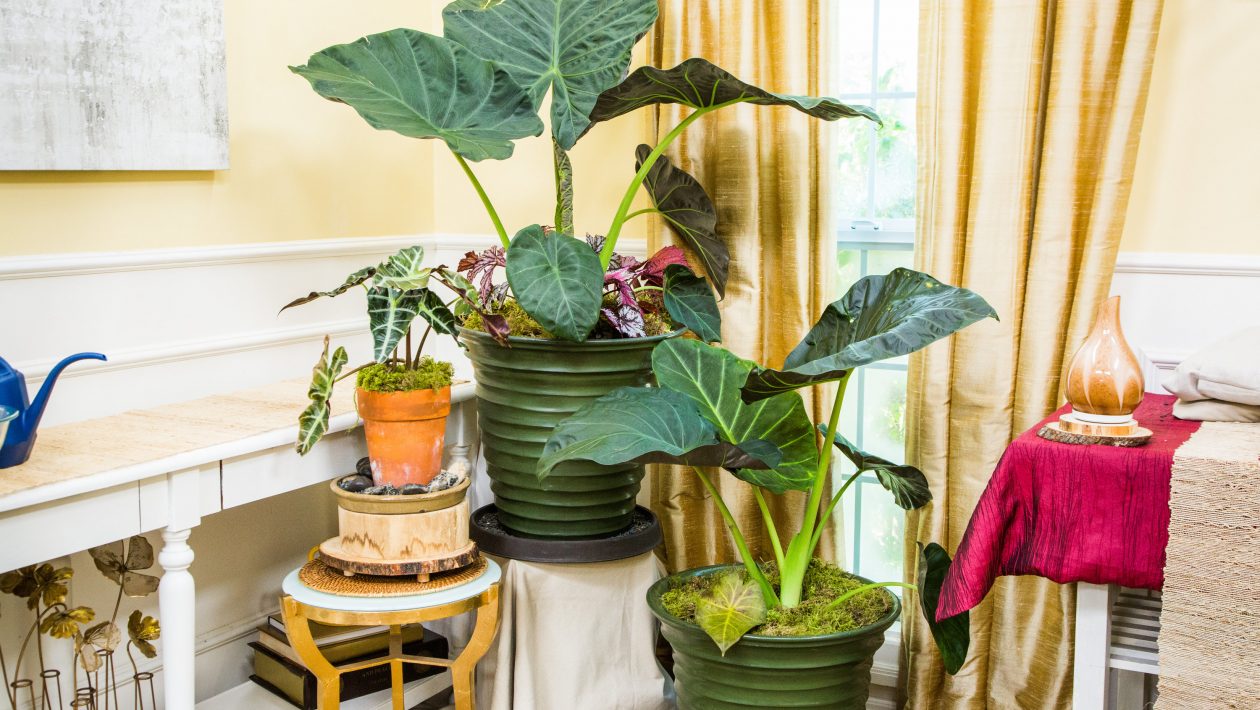Elephant ear plant is also referred to as Colocasia plant. Due to its similarity with elephant ears, it is known as elephant ear plant. It is a heat-loving plant as they come from tropical and subtropical regions. Usually these plants are commonly known for their large and tropical leaf and put a low effect in any landscape. Now in this whole article, we have covered how to grow elephant plants with proper care.
What is known as an elephant ear plant?
Elephant ear plants are considered as caladium plants or angel wings. Usually these types of plants are commonly found in natives of South America with a variety of colors and sizes. It is a tropical plant and can’t tolerate any frost.
They only appear when soil is in warm condition. You can use elephant ear plants as background plants or ground cover. They usually are used as inflection or focal points. These plants are well adapted in gardens and containers.
Elephant ear plant types:
There are several types of elephant ear plants. Each class has distinct features and unique beauty. If you know the specific characteristics of each type, then it will be easy to identify and take care according to its particular nature. The types of elephant ears as follows-
Caladium:
It has specific 10-11 growing zones and suitable to grow in gardens or as an indoor elephant ear plant. They offer an incredible range of colors, including green, white, red, and pink. It needs moist and acidic soil. Generally, these types of elephant ear plants are 6 inches to 3 feet and spread the surrounding up to 2 feet.
Colocasia: This type of plant is generally found in Asia and India. Its height is 3 to 10 feet and spread, including the surrounding space, 2 to 10 feet. Their leaves are pointed downward. They have edible tubers that are known as taro. Their size makes it different from other colocasia plants. You can also found calla lily-like elephant ear plant flower. It requires medium to wet, which implies originally rich soil. It needs full to partial sun exposure. Certain colocasia species are considered as invasive along the gulf coast.
Alocasia: However, this type of elephant ear plant is grown in subtropical Asia and some parts of Australia. Their leaves and upward and tubers aren’t edible. Its height is 2 to 6 feet and spread, including the surrounding space 2 to 6 feet.
Xanthosoma: Naturally, Xanthosoma grows in warm and humid conditions. It grows in moist, well-drained, and rich soil. Its tubers are edible, but these type of elephant ear plant is less common for growing as home plants. The height of the plant is 2 to 4 feet, and the spreading area is 1 to 4 feet. It requires partial or full shade exposure.
How to plant elephant ear rhizomes:
You can remain stress-free to plant elephant ear rhizomes. After passing the frosting season, if the temperature is above 70 degrees, then it’s time for bulb planting. Now select a proper location with full or partial sun and prepare the bed with rich soil mix by making an 8 inches depth. Smoothing is done with a squanderer to remove extra clusters of grass and stone.
For better placement, put elephant ears bulbs 3-4 feet apart.
Plant in such a way so that tip remains up. Dig a hole so that the top of the bulb remains 4 inches deeper than the soil line. Now cover with 4 inches soil. You can plant in an individual 6-inch pot using a good quality of the potting mix. And, if you want to grow on the bank, then put a rich organic soil and place elephant ear plant bulbs at the same depth. Some proper steps have to maintain to grow elephant ear bulbs properly. These are as follows-
Selection of good tubers:
It’s so much essential to choose a suitable tuber to grow elephant ear plants. Choose one tuber that is large, firm, and enviable. If the size of the bulb is more significant, then the plant will be better in size also and its leaves will even in overall shape.
Selection of right place:
A sheltered location is preferred to protect decorative leaves from strong winds. Naturally, elephant ear plants flourish in rich and uniformly distributed moist soil. Dry-type soil is not suitable for an elephant ear plant. For that in the summer season, it’s difficult to plant. Most of the elephant plant species grow in a few inches of standing water that probably 6 in. Manure, ground bark, or similar material with soil is needed to increase the organic matter with compost.
In general, elephant ear plants grow best in the sun and partial shady area. Elephant ear plants are sensitive to frost, and climate change put an impact on species variation. In more relaxed place, tubers are planted after frosting season, which means when winter is gone, and spring comes. And if you want to save your tuber bulbs for the upcoming spring season, then you can dig them on before the first frost and store them before replanting.
Plating process of elephant ears plants:
Early summer is a suitable time to plant elephant ears plant as they are considered as indoor plants, so you can also plant them 4-6 weeks before the average frosting date for earlier blossom. Again you choose an option by putting directly it in the ground after passing the frosting period. If you found the atmosphere is calm or soil temperature is cold, then it’s better to delay the planting.
It’s essential to put your tuber under 5 in deep. The distance can bring variation to your plant species. Ordinarily small and medium-sized elephant ears are spaced 18-24 inch apart, tall elephant ear species have to pant about 3-4 apart. Plant the elephant ear tuber with the sharp side facing and cover the tuber with soil and water as much as it needed. Protect the elephant ears plant from weeds and conserve soil moisture.
Aftercare:
Aftercare is also essential for the proper growth of elephant ear plants. If you consider some necessary things, then it will be easy to take aftercare. These are as follows-
- Provide regular, consistent moisture in the growing season.
- Try to keep the soil moist and don’t let it dry. For that, regular watering is an essential fact.
- Also, It’s better to apply a small portion of liquid fertilizer after every 2-3 weeks; it will help to promote the plant growth.
- Clean the weeds regularly. Keep plant protected from weeds to a depth of 2 in beds and 1 in pots.
- It’s an essential fact that elephant ears plant continuously produce new leaves in the growing season. Remove the older leaves that gradually die off. By doing so, the plants will give a neat look.
How to take care of an elephant ear plant:
As now it’s known that the growth of elephant ear plants is simple. But proper elephant ear plant care has to take that includes the following section-
Zones:
Zones of the elephant ear plant imply the area where this type of plant grows, or you can found them. Naturally elephant ear plant grows in warmer regions and native humid climates of Southeast Asia. It requires the daytime temperature of 70 to 85F and at night time, lower than 60F. It’s one beneficial thing that elephant ear plants can be replanted each year.
Overwintering:
Most elephant ears plants are sensitive to the winter season. In colder zones, the tuberous rhizomes can be excavated and stored in the winter season. For that, elephant ear plant winter care is required. If you want to keep rhizomes for next winter, then it’s better to dig them before the first frost under 45 to 55 degrees. After frosting, you have to cut back foliage and Dig up rhizomes and allow them to dry for a few days.
Now it’s’ time to store in an open container with mulch moss or dry potting soil barely covering the rhizome. When the temperature is below 40 degrees, then lift tubers for winter storage. Remove extra dirt from the bulbs or rhizomes and store in dry protection moss or wood shreds. And place in warm, dark, and dry place for winter. Check the temperature that should not be higher than 50-60 degrees F.
If you can give Alocasia bright, indirect light and moist soil, then you will be able to grow it as an elephant ear plant indoor. For protecting the rhizomes from overwintering, cover the base of the plant with 4 to 12 inches of mulch.
Exposure:
Sun exposure is an essential fact for growing elephant ear plants. Some elephant ear plants require filtered sun or partial shade or full sun. Generally, green types of plants can take higher light levels, darker leaves require filtered light or partially.
Soil:
Soil for elephant ear plant is an important fact. Most elephant ear plant requires a creamy type of soil that is moist but well-drained. Few classes are tolerable to wet soil conditions such as big leaved colocasia. Generally, big, green elephant ear plants are practically durable and tolerate the variation of the moist state. Again dark types of elephant ear plants suffer most if these are over watered. Usually these types of plants can survive in a dry condition for several days.
Watering:
Proper watering is an essential issue for any plant. Elephant ear plant is not also exceptional regarding this matter. Proper watering helps to prevent disease problems. Sometimes we like to water from above but it’s much beneficial if you water from the below at the root zone. Again, water in the morning so that the root absorbs the water till night.
Fertilizer:
For proper care, put on some fertilizer is a good choice. But it’s a good thing that elephant ear plants are not heavy feeders. For that, apply a slow amount of fertilizer while planting according to package instructions. You have to observe your elephant ear plant after putting it in a pot. If you found yellowish color, then you have to realize it has micronutrient deficiency. For that, you have to apply a fertilizer that contains micronutrients, or you can sprinkle Epson salts around the base of each plant every month.
Tips for caring elephant ear plant properly:
- It’ll be easy for you if you grow an elephant ear plant in large containers.
- Also, These plants can’t control temperatures below 50 degrees. So, while growing these plants, you have to be careful about the temperature.
- Keep the soil moist but not drenched. For that, Use a trickle system to deliver water a low pressure at the soil level.
- Elephant ears plant get the benefits from granular fertilizer after 2-3 weeks.
- Frequently check the pests and diseases of your elephant ear plant.
- Always clean weeds properly.
FAQ:
- Is it safe to grow elephant ear plant as an indoor plant?
Some consider elephant air plant poison can harm the human body. It will happen if you grow on a large scale at home. Due to containing oxalic acid in elephant ear plant leaves and stems, serious illness is caused in children or pets.
-
How can I grow an elephant ear plant in a pot?
Take a 14 to 18-inch large pot and fill it about three quarters with a lightweight potting mix. Now plant the bulb above 8 inches deep with the root side and keep it in medium indoor light to grow as a houseplant.
- What is the basic requirement to grow elephant ear bulbs properly?
Full or partial sunlight, rich & moist soil and care for overwintering is the basic requirement to grow elephant plants from ear bulbs.
- What is considered as giant elephant ear plant?
The scientific name of the giant elephant ear plant is colocasia gigantic. It’s known for its glaucous green leaves, and its leaf is much wider than other types. The measurement of this plant leaf is 5′ long and 4′ wide.





